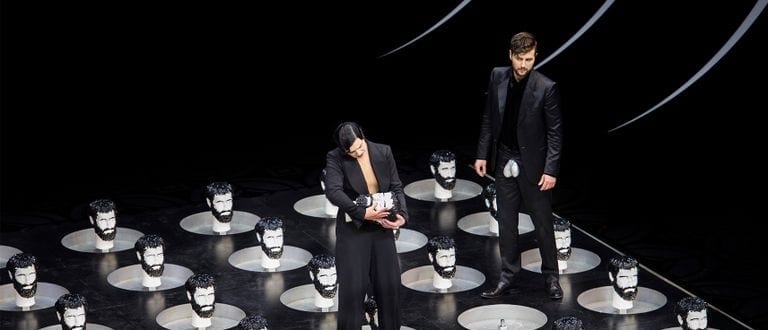We’re out today. On King Herodes’ terrace, every exuberant thing is in its place. Minimalistic black-and-white squares frame the constellation between the king, the queen, and her beautiful daughter Salome. As separate as their suitery are their dark costumes that will just fit into the gloomy atmosphere. In the back of it, overlooking the noble scene, an ominous silver phallus hangs on the slant. In the conflict of sounds crawling up from the orchestra pit presentiments of danger set up the very first scene. We’re out – dressed up for the très chic occasion of execution.
In the tertrarch’s garden, femmes fatales are the real sight among pompous decoration. Narraboth desires Salome and her stepfather does so, too. But she does not mind her admirers. Bored by the men-dominated world she lives in, the mysterious collective reverence of the whole court household towards the strange captive Jochanaan raise her interest in this strange god-sent creature. When the pale, slender man lets his baritone sound across the chess field of all players, it moves them all visibly – however, everyone ensures excellent posture on stage. But the echo of desire drowns out the prophet’s voice – for Salome, who is accustomed to full attention, irritation on Joachanaan’s turn-down on all her affection evolves into a deep physical obsession. Surprisingly, unlike all men she knew before, he will not fall for her looks and decides not to look at her at all.
Unimpressed by his wife’s attempts to become the center of his attention, Herodes continues to lay his lustrous eyes on the Salome. Nonetheless, when the lecher asks her to dance and promises to fulfill one wish in return, she suddenly listens attentively. With a little help from Wilde, the coquette consents the exchange deal and demands the captive’s head. Wilde saves the dance. And Salome from her stepfather. The one that will not be rescued is the incarnation of moral. Eventually, are we to rely on a higher power of salvation from a society as rotten as can be?
Back in the days, Richard Strauss premiered with the contemporary art of Oscar Wilde’s ‘Drama in one act’ 1905 in Dresden. He neglected the character of the playwright himself, even though Wilde’s role was initially conceptualized to act out his quarrel with his relationship to Lord Douglas. In the rigid positions, it takes somebody to direct the tragedy towards the grand finale. When “Wilde is coming”, he pulls the strings. In the end, the whole setting unfolds in an incomparable cacophony that could have probably crashed all by itself. Still, getting Wilde back on stage makes you believe that not everything happens due to an inexorable fate.
Cast and orchestra at the Staatsoper are able to unite both the revival of Strauss’s breakthrough and the sneak into the biblical, yet wild court of ultimate resort. Conductor Thomas Guggeis and his fellow players know just how to elaborate on the melodic dissonance between Salome and Jochanaan and a good shout to a marriage on the rocks between Herodias and Herodes. In the end, every call of longing is responded to in agony – music becomes the perfect match to project a contradictory constellation on stage. In that way, one feels the vibes of desire as a cruel sensation when unfulfilled. The mismatching feelings for one another are determined to result in anything but love. At the peak of emotional breakdown, one decides to kill or die. If you cannot decide for yourself, then someone else will.
Everything is going to be fine in the end. If it’s not fine, it’s not the end. Right?

